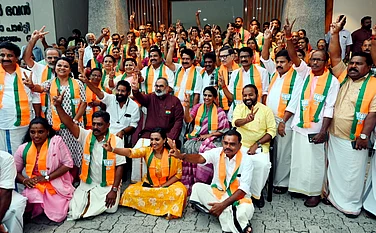
Temples across Telangana have evolved into major cultural, economic, and political hubs, prompting both state and central governments to invest heavily in their development.
The Centre has allocated Rs 800 crore for temple restoration and infrastructure, including Rs 73.74 crore for the Ramappa Tourism Circuit and Rs 68.10 crore for the Someshwara Temple Circuit.
Former Tourism Minister G. Kishan Reddy highlighted ongoing projects across key sites such as Ramappa, Jogulamba, Bhadrachalam, and the Tribal Circuit in Mulugu and Medaram, positioning temple revival as both a cultural and tourism initiative.
Temples in Telangana are no longer just places of worship. They have transformed into cultural, economic, and political epicentres, drawing both pilgrims and policymakers alike. With footfalls rising sharply across shrines—major and minor—in the past decade, the state and Union governments are now competing to outdo each other in allocating massive funds for temple renovation, infrastructure, and festivals.
From Yadagirigutta to Ramappa, from Vemulawada to Bhadrachalam, a new wave of spiritual rejuvenation is sweeping across Telangana, backed not just by devotion but also by the deep undercurrents of politics and tourism.
The Union government, under the Ministry of Tourism and the Ministry Home Affairs, has placed a sharp focus on Telangana’s historical temples. In particular, the 13th-century Ramappa Temple in Warangal, a UNESCO World Heritage Site, is witnessing a revival, with Rs 800 crore allocated for its renovation and surrounding its infrastructure. Alongside, the Centre has sanctioned Rs 73.74 crore for the Ramappa Regional Sustainable Tourism Circuit and Rs 68.10 crore for the Someshwara temple circuit, aiming to integrate spiritual heritage with tourism development.
G. Kishan Reddy, who was recently moved from the tourism portfolio to coal and mines, has been vocal about his government’s commitment to the revival of temples. Recently, inaugurating the façade illumination of the Swayambhu Temple complex at Warangal Fort, he announced that the Centre is spending Rs 800 crore across various cultural and tourism centres in Telangana, including Jogulamba Temple, Bhadrachalam Temple, and the Tribal Circuit covering Mulugu and Medaram.
“The Centre will develop all historical monuments in the state. The Natya Mandapam at the Thousand Pillars Temple will be dedicated to the public on Mahashivratri,” Kishan Reddy said.
Clearly, the Bharatiya Janata Party (BJP) at the Centre sees cultural revival not merely as heritage conservation, but also as a strategic investment in winning the hearts of Telangana’s Hindu majority population.
Not to be left behind, the Congress government in Telangana has unveiled ambitious temple development plans with a whopping Rs 2,900 crore allocation, making it one of the largest packages ever sanctioned for religious infrastructure.
At the heart of this push lies Yadagirigutta, a town that was officially renamed Yadadri. The temple, dedicated to Lord Lakshmi Narasimha, had already undergone a facelift under the previous Bharat Rashtra Samithi (BRS) government, but now the Congress regime wants to elevate it to the stature of Tirumala Tirupati Devasthanams (TTD).
Deputy Chief Minister Mallu Bhatti Vikramarka announced in the state assembly that a Yadagirigutta Temple Trust Board will soon be constituted on the lines of the TTD, ensuring professional management and future expansion. A golden Vimana Gopuram with 60 kg of gold already crowns the temple, and the grandeur of its Samprokshanam (consecration ceremony) earlier this year set the tone for its growing prominence.
Meanwhile, the government has also turned its gaze towards the Bhadrachalam Temple, often called the “Ayodhya of the South”. In a bold step, the state sanctioned Rs 34 crore to acquire land for the expansion of the temple complex, with a rehabilitation package for 39 families in the area. Each displaced family has been promised Rs 7.86 lakh and a flat, ensuring a smoother relocation.
Temple authorities have finalised designs for an extended “Temple City” concept, and construction is expected to begin after Sri Ram Navami celebrations.
Another significant allocation has gone towards the Sri Raja Rajeshwara Kshetram, often hailed as the “Kashi of the South”. The government sanctioned Rs 100 crore for its development, including better amenities for the pilgrims, roads, and cultural programming.
At Basara’s Sri Gnana Saraswati Temple, the Congress government has launched the Godavari Harathi programme, blending devotional ritual with tourism spectacle.
Equally, the state has not ignored cultural festivals. For Bonalu, Telangana’s most vibrant festival dedicated to goddess Mahakali, the government has earmarked Rs 20 crore this year. Deputy Chief Minister Bhatti Vikramarka, while offering pattu vastralu (silk garments) to the goddess, emphasised that Bonalu is not just a festival, but “the soul of Telangana’s culture”.
These decisions are being interpreted as the Congress government’s strategy to shed its “pro-minority image” and reconnect with the Hindu electorate, especially as the BJP expands its reach from urban pockets into rural areas.
Interestingly, the BRS government that ruled earlier had already invested heavily in temple renovation—Yadadri being the crown jewel. Critics had argued that this was part of BRS’ attempt to counter perceptions of Muslim appeasement and prevent the BJP from monopolising Hindu votes.
Now, the Congress seems to have inherited and expanded the same template. Political analysts believe that the “temple race” reflects not only genuine preservation of Telangana’s cultural fabric, but also the emerging contest for the Hindu vote bank.
The BJP, with Kishan Reddy’s aggressive temple-centric announcements, is attempting to position itself as the authentic custodian of the Hindu spiritual heritage. Meanwhile, both the BRS and the Congress are vying to ensure that the party of Hindutva does not steal the political narrative entirely.
Beyond politics, what is undeniable is the phenomenal rise in temple visits. Members of the Archaka Sangam―an association of Hindu temple priests―admit that in the past decade alone, pilgrim footfalls have surged at a rate “never witnessed before”. “It’s amazing, but true,” says Ramagiri Sharma, the president of the state’s Archaka Sangam, duly recognised by the government. He says this phenomenon is due to the changing mindset of a majority of Hindus. Temples, which were once considered modest shrines, now witness lakhs of visitors annually, driven by better roads, improved facilities, and rising cultural consciousness.
This surge has also translated into economic opportunities. Temple towns like Yadagirigutta, Bhadrachalam, and Vemulawada are witnessing a surge of new hotels, eateries, transport services, and cottage industries, providing livelihood to thousands. For a state like Telangana, temple tourism is rapidly becoming as critical as information technology or pharmaceuticals in shaping local economies.
The investments in temples are not just about stone and mortar; they are about reclaiming identity. In a state that celebrates its tribal traditions, Muslim heritage, and Christian institutions, the renewed emphasis on Hindu temples signifies an assertion of cultural balance.
By institutionalising temple boards, expanding pilgrim amenities, and integrating tourism circuits, the governments—both state and Union—are ensuring that Telangana positions itself as a premier spiritual tourism hub of India.
With the Yadagirigutta Temple Trust Board on the horizon, Bhadrachalam’s expansion, and Ramappa’s global spotlight, Telangana may well become the new epicentre of temple-based tourism, rivaling Andhra’s Tirumala and Tamil Nadu’s Rameswaram.
So, whether driven by politics, devotion, or economics, Telangana’s temples are emerging as the focal point of a new cultural renaissance. As devotees throng in ever-increasing numbers, and as governments continue to pour in crores for their development, these sacred spaces are set to redefine not just the religious map of the state, but its cultural identity and economic future as well.
The race to renovate, expand, and glorify temples may have political undertones, but its outcomes—revitalised traditions, stronger local economies, and enriched spiritual tourism—will leave a lasting imprint. Telangana’s temples, once local centres of faith, are now poised to become national and even global icons of cultural heritage.
(Views expressed are personal)
























